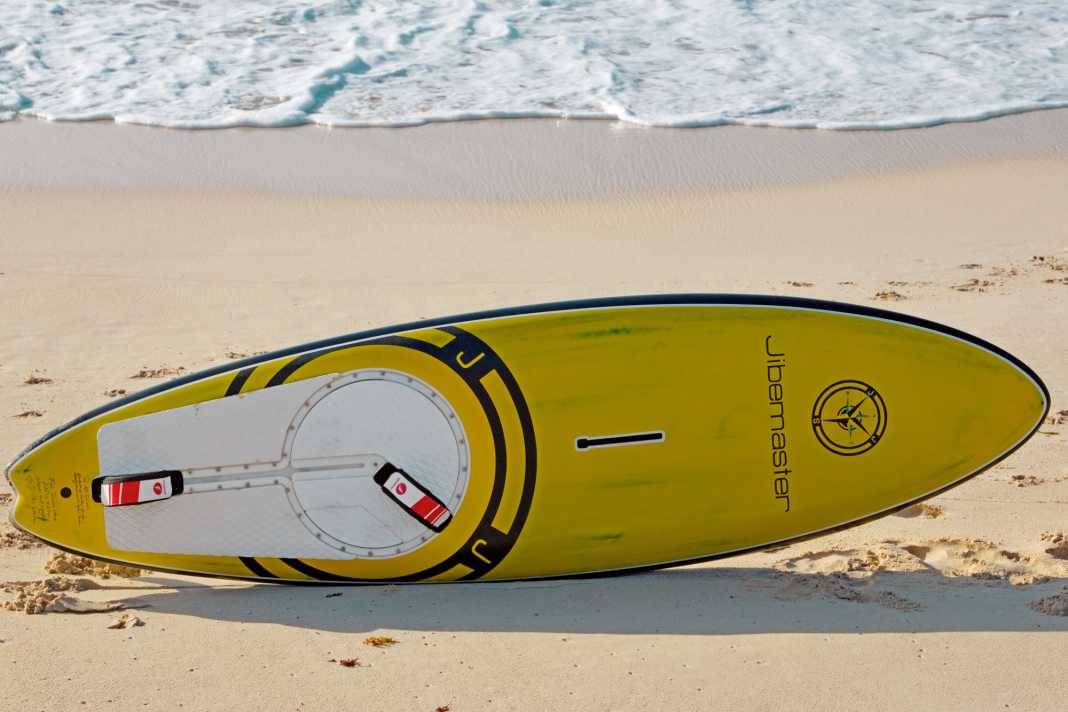





Jibing doesn't work without leaving the straps at some point and surf shoes stink! This has always been the case and will still be the case in 100 years' time. But because there are windsurfers who stubbornly refuse to accept such laws of nature, using saws, hammers and sandpaper, there are always ideas that oscillate somewhere between "funny", "pragmatic" and sometimes "ingenious". We took a look to the left and right of the windsurfing mainstream and introduce you to some DIY kings and their ideas.
Kai Sundin Gjessing and his board with adjustable rocker
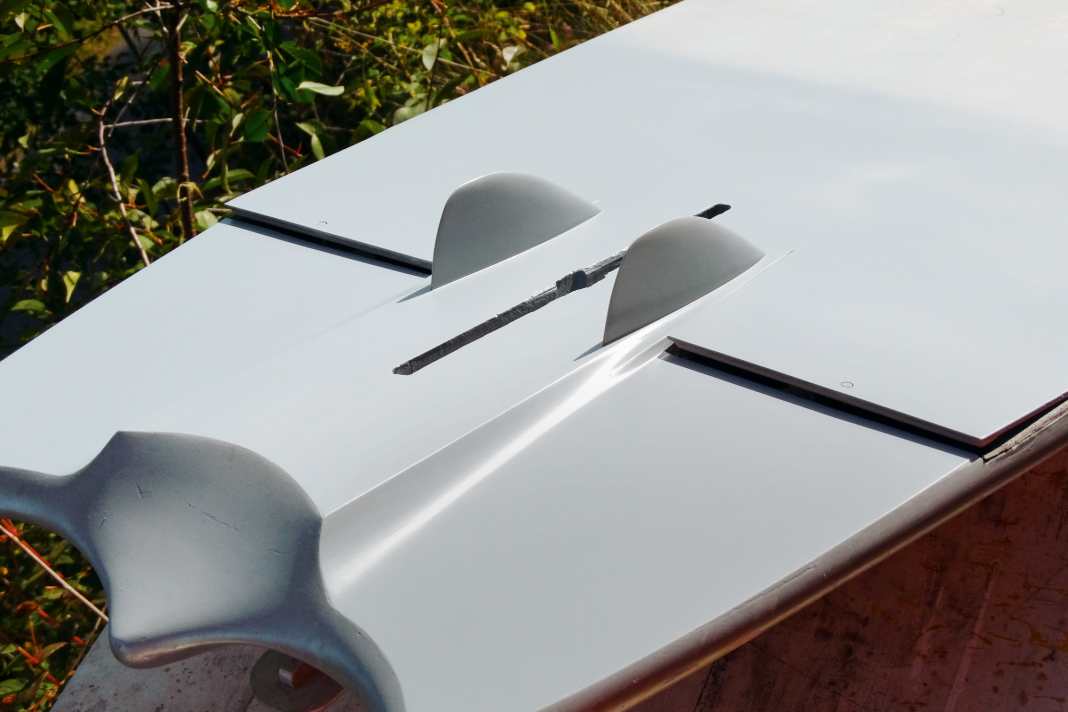




Kai, you built a board yourself where you can change the rocker, i.e. the bend in the tail, using a pedal. What is the idea behind it?
The idea comes from the dream that every windsurfer has - a board that can do everything: It should glide well, be fast in a wide wind range and still be easy to turn. I can let my board make fast and tight hooks without using my body, almost from the ankle - a great feeling. I've had this concept in my head for ten years. The 2in1 concept from F2 (a board that could be fitted with a flatter underwater curve, the ed.) encouraged me in my endeavour, because if series manufacturers started doing this, there had to be a real need for it. The bottom line is that I think a concept like mine makes much more sense than F2's. After all, I can adjust the rocker while surfing and don't have to go to the beach to do it.
What were the biggest challenges during implementation?
The difficult thing was to design the folding mechanism to be as small as possible, but still have a big impact. It also had to be light yet stable and, last but not least, everything had to look stylish.
What is your technical background? You don't just build a concept like this as a layman, do you?
I'm not a trained engineer or anything like that - but I would describe myself as creative. I've done film production, furniture design, bicycle mechanics and music.

How exactly does your concept work technically?
The mechanism I developed to operate the adjustable wings is simple and robust. The most difficult part was the pedal mechanism: what would work best, be solid, light and above all not get in the way? Hydraulic or cable-operated, smooth or stiff, latching or free-moving wings? There were 1000 things to consider. The pedal alone took four days of work. I can now operate the pedal behind the straps with my foot and use it to raise or lower the movable wings in the underwater hull. I can make the curve flatter to go straight ahead, which makes the board faster, but if I want a board that turns easily, I can make the rocker line rounder.
Did you make all the parts yourself?
No. I used aluminium for the moving parts, which, to be honest, I found at a recycling centre and in an old industrial building. An old ski binding also provided parts. The wings in the underwater hull are made of the same material as the police shields - courtesy of my little brother.
The board itself doesn't look like a series either...
Of course, I didn't take a brand new board to try this out! It's a friend's old Tabou 3S, which I modified a bit by making it shorter and a bit wider at the back. It was a strange feeling to put the saw to a working board (laughs). But it just had to be done!
What were your first experiences on the water like?
The system has now worked for a year without any problems and has been on the water for many hours. I'm very happy with it and I secretly hope that a board manufacturer will take up my idea and put it into series production.
The construction looks a little martial and heavy...
The pedal weighs 260 grams, the whole construction including the flaps 450 grams. You could make it much lighter by using carbon, Dynemaa or reinforced plastic. I would like to develop the system further together with a brand and possibly even try to solve this electronically, using a remote control - such a system could disappear completely into the deck. Operating the pedal at high speed and chop can sometimes be tedious.
Jörn Hesse and his board, where the straps rotate in the jibe
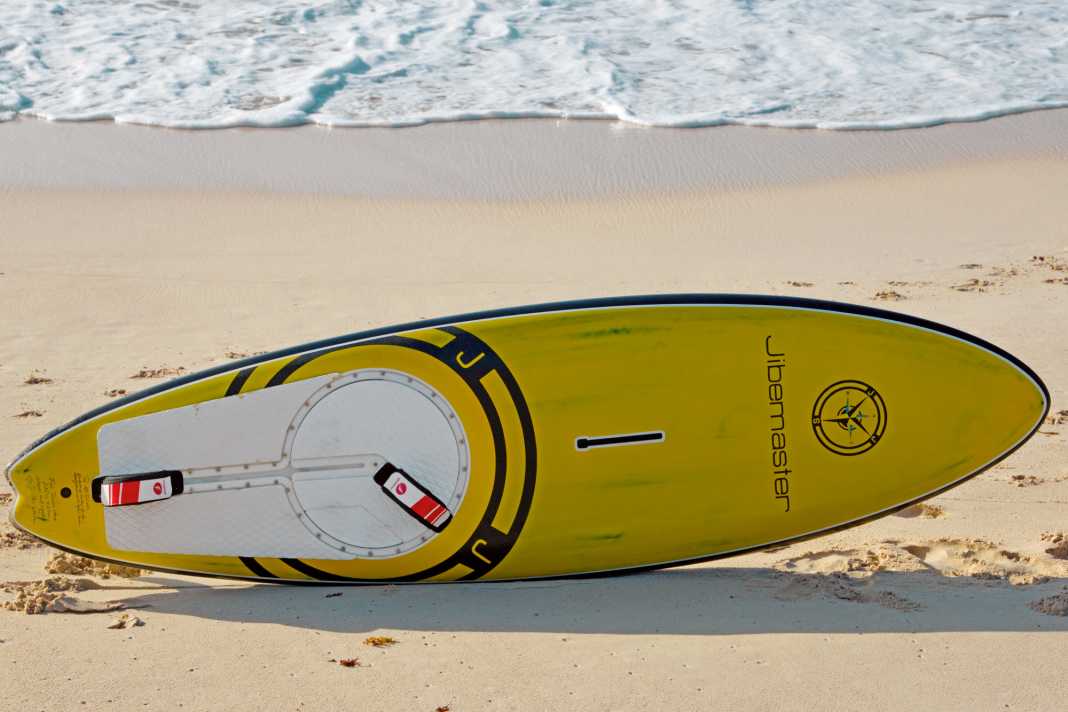





Jörn, you have also been creative and developed a board with rotating straps. Why did you do this?
I am a hobby windsurfer and live 50 kilometres south of Hanover. That means it's a long way to the coast and is only worthwhile at the weekend or for a holiday trip. The good days to develop my windsurfing level are therefore limited. I once learnt to jibe on big boards and flat water and at least mastered it enough to get round the bend. The next steps were tedious - when the waves got higher, the boards had less than 100 litres of volume and the wind picked up, I regularly went swimming when changing feet. I was always going round in circles, jibing from time to time, but then starting all over again after the long winter at the latest. I then thought about how I could make jibing easier and started to design various prototypes. The aim was to develop a design that was as mechanically simple as possible, had a minimal weight and was also resistant to salt water and sand.
How exactly does the mechanism work?
A rail is built into the deck in which the rear strap can slide forwards into a turntable. This rotates 135 degrees and in turn releases the other strap to slide backwards.
What do you think are the advantages of the concept?
The advantages of this system are that the surfer can move their feet along predetermined paths on the board without having to leave the foot straps. On the one hand, this guarantees that the feet cannot be in the "wrong" position and, on the other, that the surfer always has maximum connection to the surfboard. Furthermore, the rear foot position can be moved along the longitudinal axis of the surfboard as required, depending on the desired course. The system offers the option of following a predefined path when jibing. This sequence of movements can be learnt very quickly after a short familiarisation period.
How do you ensure that straps and turntables do not move unintentionally during normal surfing?
Unwanted slipping of the foot straps on the board while surfing is not possible, as the system is designed in such a way that the fixed position is always guaranteed when pressure is applied to the board via the heels. This means that if the foot straps are to be moved on the board, the pressure must be deliberately removed from the hook and then applied again once the movement is complete in order to fix the strap in place.
What happens if you want to do a tack? Then the straps will be on the wrong side after the foot change, right?
This also works: slide your back foot completely forwards, luffing the board. Then pull the front foot out of the strap and place it against the base plate, take the back foot out of the strap and initiate the turning movement of the plate. After changing sides, complete the turning movement of the disc with the front foot, go into the straps and move the rear foot back to the desired riding position.

Your system has been realised with top craftsmanship. How can you do that?
I studied mechanical engineering at the University of Hanover and work in project management in a medium-sized company. I create the design using CAD/CAM solutions (3D computer programmes, the ed.). For the realisation, I have access to CNC milling machines with which I carry out the production.
Which board did you use for your modification?
I got the prototypes from Dieter Jocham (Horney Windsurfing, the Red.) for my needs, as the topwater hull and the inner board construction had to be specially adapted to the system and the load. We designed the deck mould together so that my construction could be fitted precisely. The board was practically built around the construction. I use a 95-litre twinser waveboard, for which I developed my own design and the "Jibemaster" logo.
Axel Semke and his ventilation system for smelly surf shoes
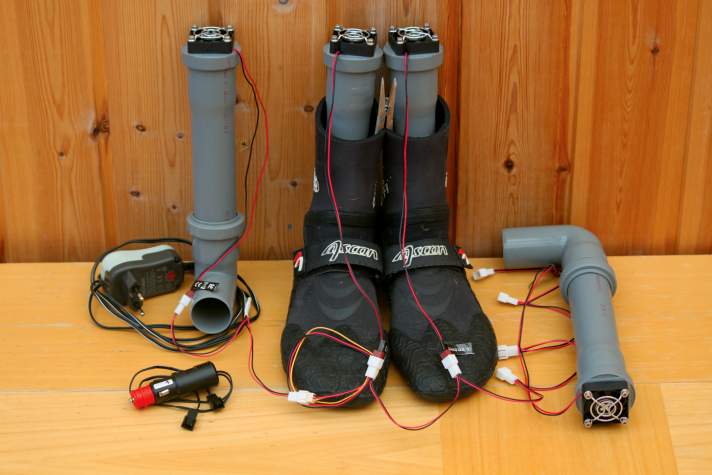
Despite rinsing and careful drying, my surf shoes often stank after a few days. My self-made surf shoe fans solve the problem. Quiet and energy-saving fans blow fresh air into the shoes (<1 knot "wind speed"). The constant exchange of air removes moisture. The shoes feel dry after just one night and are completely dry after around two days.
To build each shoe, you need: 20 centimetres of straight drain pipe, a bend, a PC fan with a diameter of around 40 mm, a fan grille, four M3x20 mm stainless steel screws and some silicone.
Saw off the edge of the straight pipe above the flange, screw on the fan (pre-drill with 2.5 mm and screw the screws into the plastic) and finally attach the bend. As the PC fan does not fit exactly on the tube, I cut 1 mm silicone seals and put them in between, but some silicone from a tube will do.
I use a 12V plug-in power supply. With "Molex adapters/distributors" (from PC accessories), several fans can be conveniently connected. You can also operate the fans from the car battery (cigarette lighter socket or trailer socket). It is essential to use a plug with a 1A fuse, as the thin wires of the fans do not fit the 16A or 25A fuse. Please do not discharge the car battery by airing many shoes for days on end (ten hours of airing requires approx. 1Ah).
Uli Kallenberger and his neck trainer for the terrace
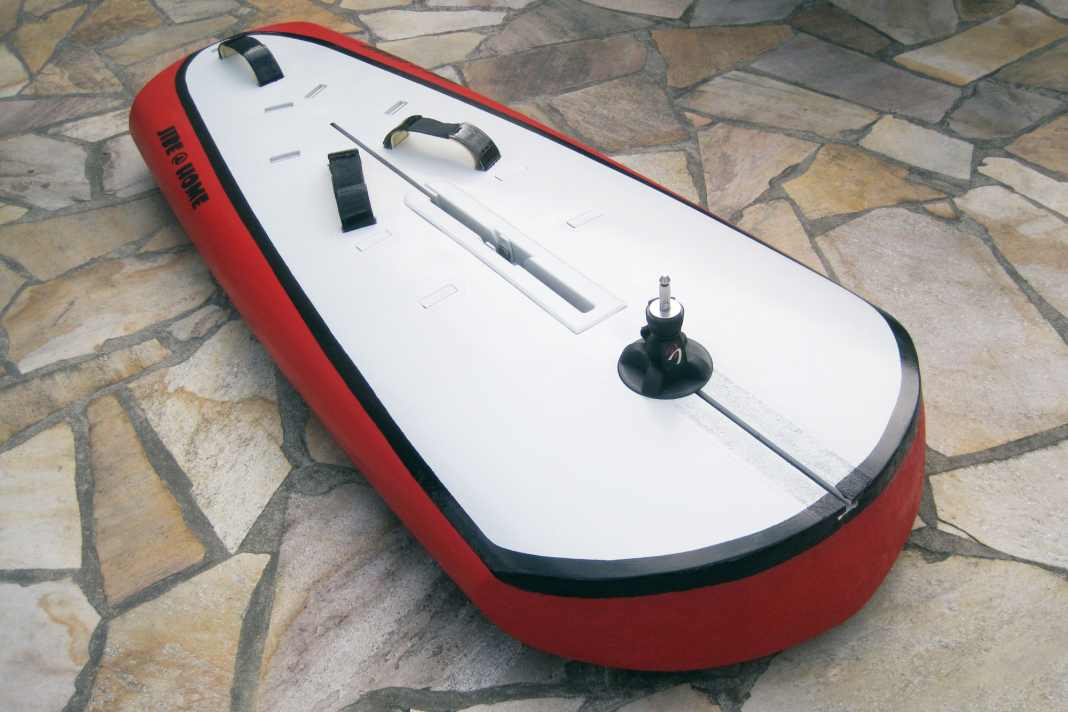


I came up with the idea of building my Jibe@home training device because I only get to surf for a few days every year. So I needed a training device for the terrace that I could use for half an hour for a short workout. In the few surfing days of the season after building "Jibe@home", I've already done a few jibes!
Seven rollers are mounted under the board so that the board can rotate 360 degrees around a pivot point between the base plate and the front foot straps. In the horizontal position, only the two centre rollers at the front and the centre roller at the back touch the ground, which makes the whole thing quite tippy - you have to keep your balance or consciously shift your weight to the edge of the board. Sail steering allows me to turn the board on the spot and practise foot and grip changes, which is where the outer wheels come into play. I use normal inline wheels as rollers. The board in the pictures used to be a Fanatic Racy Cat, the big old boards are better because you have more thickness to accommodate the wheels.
Wolfgang Mielke and his extendable water start aid
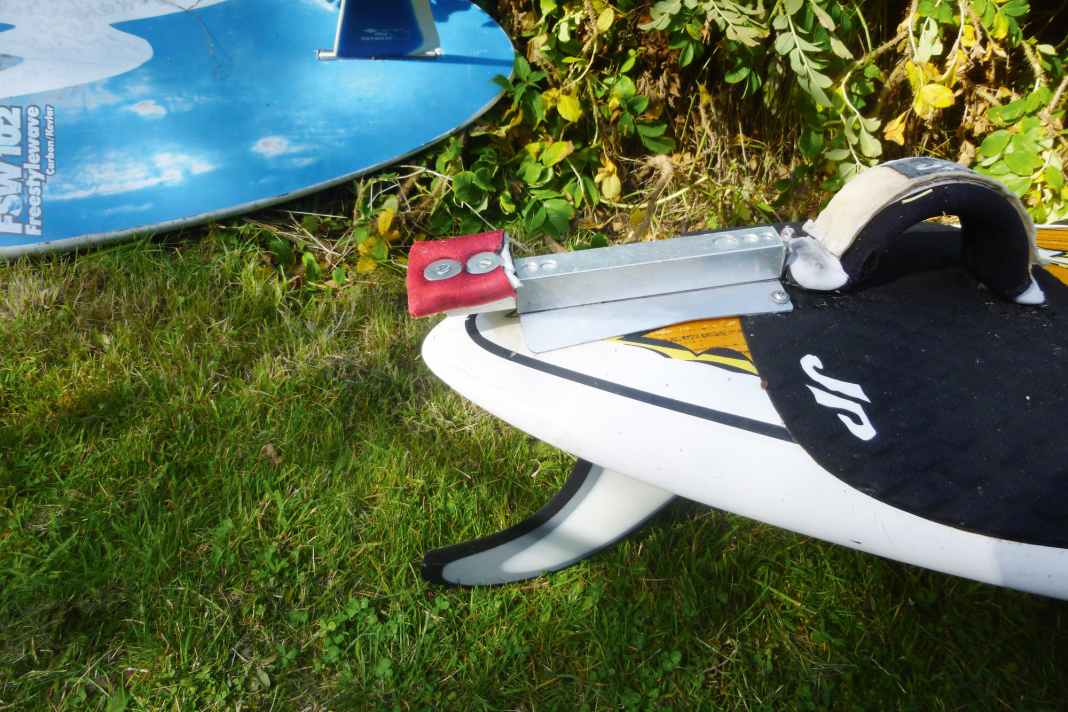


"There was a photo of Kurt Denk's water start aid in a surf summer issue in 2015. I was pleased to see that someone was thinking along again. My design is also easy to replicate and is fixed using the loop plugs. I have been using a somewhat more complex elasticated telescopic construction for about six years. As soon as the boom is lifted during a water start, the tube snaps back as there is a rubber band inside. The pad on the boom only serves to protect the sail. A water start without this aid would otherwise be difficult and require a lot of effort in steep, high waves on the Baltic Sea. I can also use it to bring the board into any position without any problems and am immediately on the board in the event of a gust. "
This article first appeared in surf 4/2016

